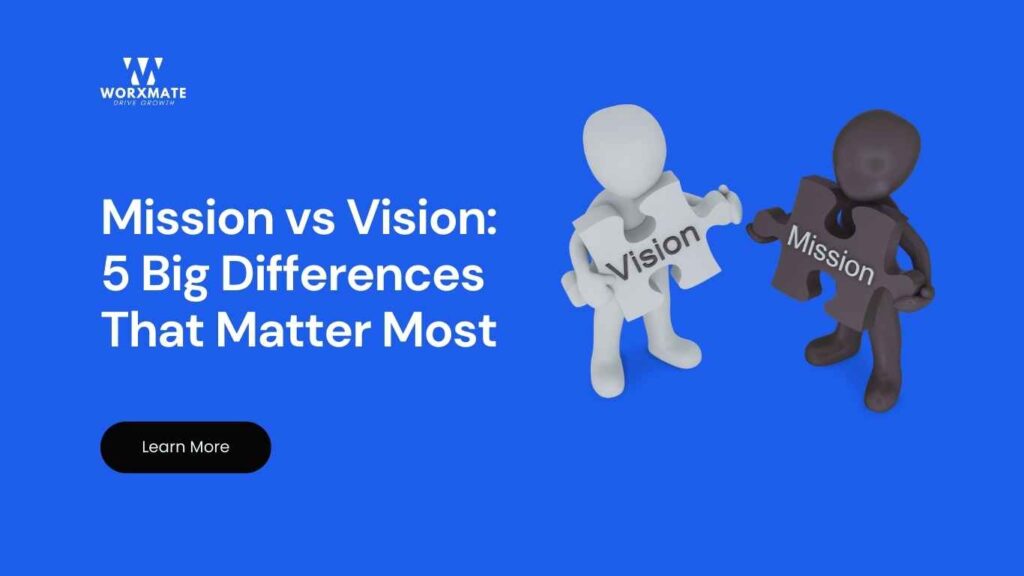In today’s competitive landscape, the discussion of mission vs vision is more relevant than ever. Understanding the difference between these two core elements not only shapes your company’s strategy but also defines your corporate culture.
Whether you’re refining your brand mission statement or establishing a new company vision, clarity is key. This blog post dives deep into the topic, explains how each element impacts your business, and provides actionable insights that every leader should consider.
Stick around to discover how the right balance between mission and vision can drive your business forward and enhance employee engagement from the very start.
What is a Mission Statement?
A mission statement is a concise declaration that defines the purpose of your organization. It outlines what your company does, who it serves, and the value it provides.
Often, corporate mission statements are the first step in creating a strategic framework, offering direction to employees and stakeholders alike.
Whether you’re reviewing business mission examples or drafting your own, the mission statement should embody your brand’s identity and drive its day-to-day operations.
Key Elements of an Effective Mission Statement
- Purpose-Driven: Clearly communicates why your business exists.
- Target Audience: Identifies who benefits from your services or products.
- Core Values: Highlights the principles that guide your decisions.
- Simplicity: Easy to understand and remember.
Example:
Google: “To organize the world’s information and make it universally accessible and useful.”
What is a Vision Statement?
While a mission statement explains your organization’s current purpose, a vision statement paints a picture of the future. It’s a forward-thinking declaration that inspires and motivates by setting long-term goals.
Unlike day-to-day operations, a vision statement is all about the aspirations of the company—what it strives to become.
When evaluating mission vs vision statements, it’s clear that while both serve unique purposes, the vision is your roadmap to future success.
Core Characteristics of a Vision Statement
- Future-Oriented: Describes the desired future state of your organization.
- Inspirational: Motivates employees and stakeholders to work towards a shared goal.
- Ambitious Yet Achievable: Sets a challenging but attainable direction for the company.
- Concise: Easy to remember, ideally encapsulated in a short, powerful statement.
Example:
Tesla: “To create the most compelling car company of the 21st century by driving the world’s transition to electric vehicles.”
Key Differences Between Mission and Vision
Understanding the difference between mission and vision is crucial for crafting effective corporate messaging. Below is a breakdown of the primary distinctions:
| Key Aspect | Mission Statement | Vision Statement |
|---|---|---|
| Time Orientation | Focuses on the present – what your organization does right now. | Looks to the future – what your organization aspires to be. |
| Purpose | Defines the company’s purpose and its primary objectives. | Provides inspiration and direction, establishing long-term goals. |
| Audience Engagement | Engages employees by clarifying daily activities and priorities. | Inspires stakeholders and investors with a long-term strategic outlook. |
| Content Focus | Highlights core services, products, or values. | Emphasizes future aspirations and potential growth trajectories. |
This clear delineation ensures that each element works together to create a comprehensive strategy, guiding both internal processes and external communications.
Vision vs Mission: A Comparative Overview
When comparing vision vs mission, it is important to consider their roles within an organization:
- Strategic Alignment:
A well-defined mission anchors the daily operations, while a robust vision keeps the long-term strategy on track.
- Employee Engagement:
Employees who understand the mission can see how their daily efforts contribute to the overall purpose. Conversely, a compelling vision can boost morale by providing a sense of future achievement. - Stakeholder Communication:
Investors and partners often seek clarity on both the current and future states of the company. Mission statements provide reassurance of current operational stability, whereas vision statements offer a glimpse into future innovations. - Marketing and Branding:
Both mission and vision play a significant role in shaping your brand’s identity. A cohesive narrative that blends both aspects can lead to stronger brand loyalty and a distinct market presence.
Crafting Impactful Mission vs Vision Statements
When developing your company’s mission vs vision statements, consider these best practices:
- Engage Stakeholders:
Involve team members from various departments to gather diverse insights. This collaborative approach ensures that the statements resonate across the organization. - Keep It Simple:
Avoid jargon and complex language. Aim for clarity and brevity so that everyone, from new hires to seasoned executives, understands the message. - Align with Core Values:
Both statements should reflect the core values of your company. They should be authentic and relatable. - Review and Revise:
As your company evolves, revisit your mission and vision to ensure they remain relevant. Adaptation is key to long-term success. - Use Visuals:
Enhance your content with visuals. For instance, the image below clearly illustrates the mission vs vision dynamic in a business context:
Alt Text: “mission vs vision overview”
Case Study: Gartner’s Mission & Vision
Gartner Inc., a global leader in research and advisory services, exemplifies how mission and vision statements drive organizational success.
- Mission Statement: “To equip business leaders with indispensable insights, advice, and tools to achieve their mission-critical priorities today.” This highlights Gartner’s focus on actionable insights for immediate impact.
- Vision Statement: “To build successful organizations of tomorrow.” This reflects Gartner’s long-term aspiration to shape the future of businesses globally.
By aligning its operations with these statements, Gartner has become a trusted advisor for over 14,000 enterprises worldwide.
Examples of Corporate Mission and Vision Statements
To illustrate the concepts, here are some business mission examples from various industries:
- Corporate Mission Statement Example:
“To deliver innovative solutions that drive the digital transformation of businesses worldwide.”
Focus: Innovation, global impact, digital transformation. - Brand Mission Statement Example:
“To create memorable customer experiences through outstanding service and quality products.”
Focus: Customer-centricity, service quality, product excellence. - Company Vision Statement Example:
“To become the world leader in sustainable technology by 2030, empowering communities and protecting the environment.”
Focus: Sustainability, leadership, future impact.
These examples serve as inspiration for crafting your own unique statements that capture both the essence of your current operations and your aspirations for the future.
Aligning Your Business Strategy with Your Mission vs Vision
Integrating your mission and vision into your overall business strategy is a critical step toward success. Here’s how to ensure that your strategy is aligned:
- Strategy Workshops:
Conduct regular workshops with leadership teams to discuss and refine the alignment of daily operations with long-term goals. - OKR Integration:
Leverage tools like Worxmate’s OKR Software to set measurable objectives and key results that reflect both your mission and vision. This helps maintain focus and ensures accountability at every level. - Performance Reviews:
Regular performance reviews should measure progress not only against immediate goals but also against your strategic vision. This dual focus can help identify areas for improvement and drive innovation. - Communication Channels:
Use internal communication channels—such as newsletters, intranet updates, and team meetings—to reinforce the mission and vision daily. Consistent messaging fosters a culture of alignment and engagement. - Feedback Loops:
Create systems for collecting feedback from employees and stakeholders. Use this input to refine strategies and ensure that the mission and vision remain relevant as the market evolves.
Conclusion: Elevate Your Business with Worxmate
In conclusion, understanding the mission vs vision distinction is essential for steering your business toward long-term success.
By clearly articulating what your company does now and where it aims to go, you build a solid foundation for growth, innovation, and employee engagement.
Worxmate’s cutting-edge OKR Software are designed to help you align daily operations with strategic goals seamlessly. Ready to transform your business strategy? Try Worxmate today, and take the first step toward a more focused, motivated, and successful organization.



